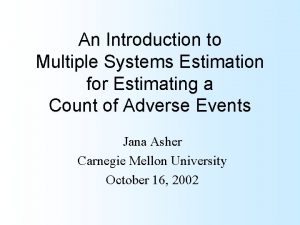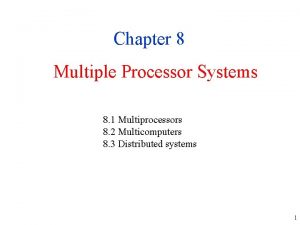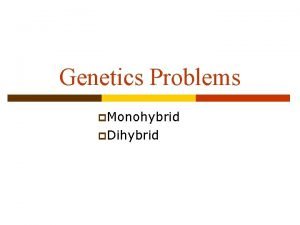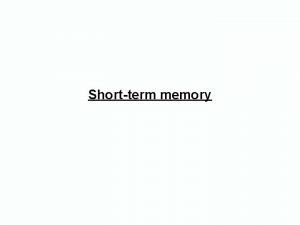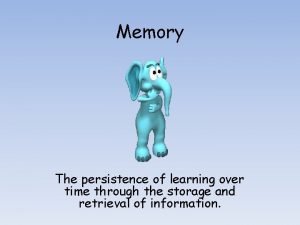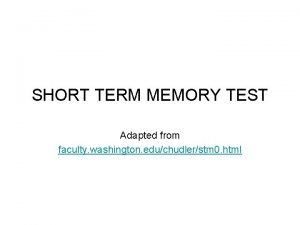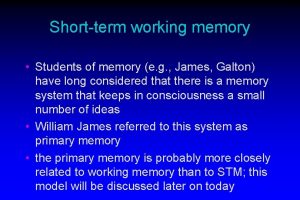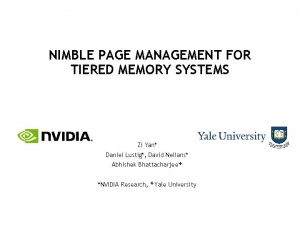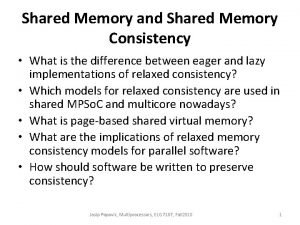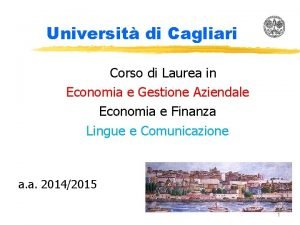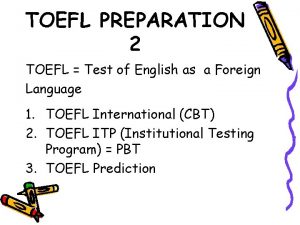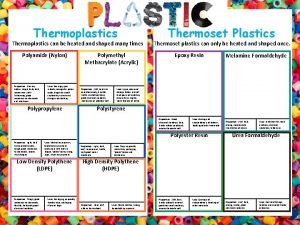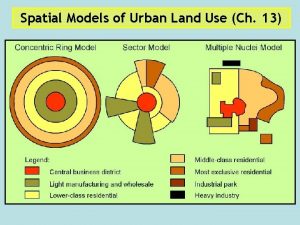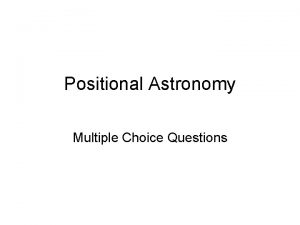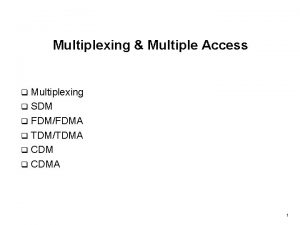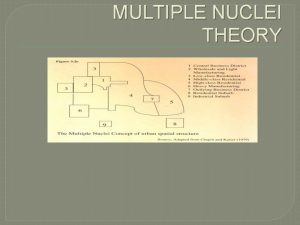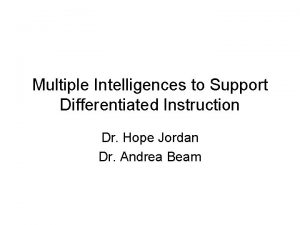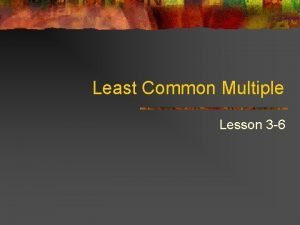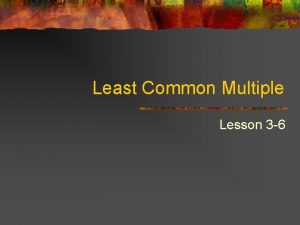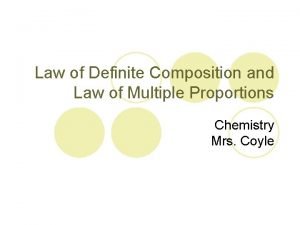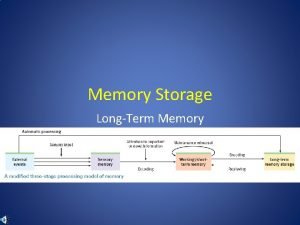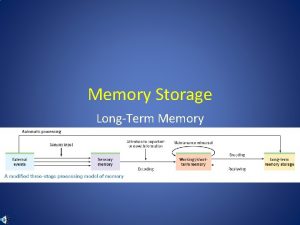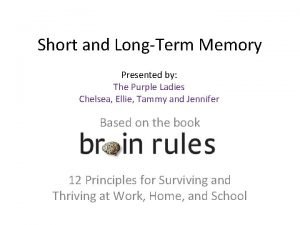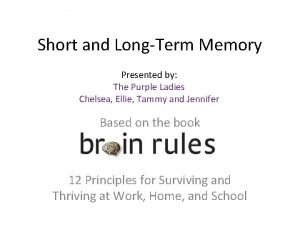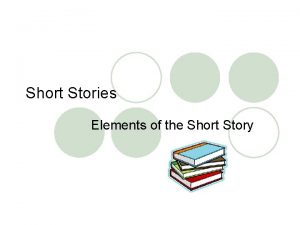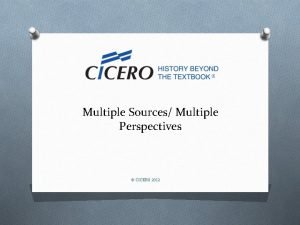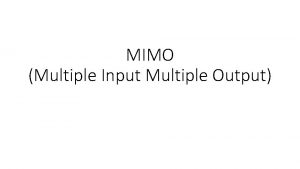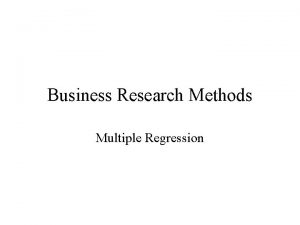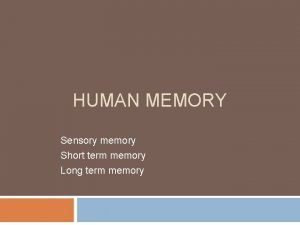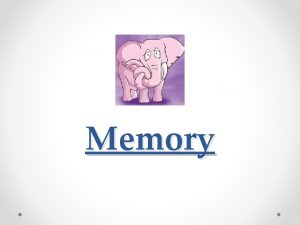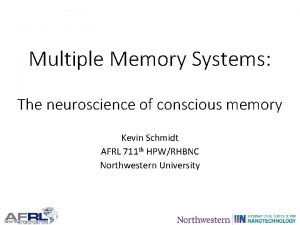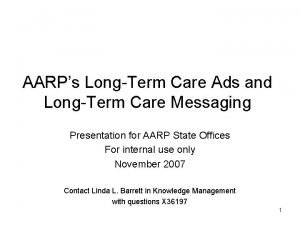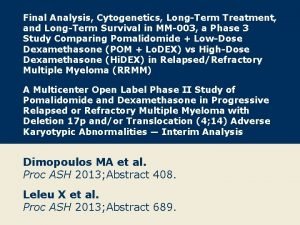Memory Memory Multiple Memory Systems Short and Longterm




















































- Slides: 52

Memory

Memory • Multiple Memory Systems – Short and Long-term Memory – Declarative and Procedural Memory – Explicit and Implicit Memory • Memory Processes – Attention – Consolidation – Organization and Retrieval • Improving Memory

Multiple Memory Systems

Multiple System Memory Models Proposed by Atkinson & Shiffrin, 1968)

Working Memory Model

Where Are Memories Located? • Memory tends to be localized and distributed throughout the brain--not just the cortex. ©John Wiley & Sons, Inc. 2007 Huffman: Psychology in Action (8 e)

Anatomical Sites of Memory

Biological Bases of Memory Biological changes in neurons facilitate memory through long-term potentiation (LTP), which happens in at least two ways: 1. repeated stimulation of a synapse strengthens the synapse, and 2. neuron’s ability to release its neurotransmitters is increased or decreased. • ©John Wiley & Sons, Inc. 2007 Huffman: Psychology in Action (8 e)

Biological Bases of Memory (Continued) • Hormones also affect memory (e. g. , flashbulb memories-vivid and lasting images are associated with surprising or strongly emotional events). ©John Wiley & Sons, Inc. 2007 Huffman: Psychology in Action (8 e)

Dual Mode Principle

What are stored in Memory: Motor Programs or Internal Models • stored (LTM) (size will depend on practice) • planned before initiation • reduced attention demands

What is Stored? Specific vs. Generalized Motor Program general memory representation of a class of actions that share some invariant characteristics • relative time • relative force • sequencing or ordinal structure concerned with pattern of movement – not specific movement

Parameters Some feature of the movements have to be changed (variant) each time to make the movement fit the circumstance or goal • movement time • movement amplitude • limbs and muscles used

Variations in Movement Time • Can change speed of throw – Does movement pattern change drastically? • Armstrong (1970) – Movement pattern re-produced as fast as possible but proportion times remained the same

Recall Versus Recognition Recall • you must retrieve the information from your memory • fill-in-the blank or essay tests Recognition • you must identify the target from possible targets • multiple-choice tests

An Example of Recognition Vs. Recall • Research shows people are better at recognizing photos of previous high school classmates than recalling their names. ©John Wiley & Sons, Inc. 2007 Huffman: Psychology in Action (8 e)

The Memory Process Three step process…. 1. Encoding: The processing of information into the memory system. 2. Storage: The retention of encoded material over time. 3. Retrieval: The process of getting the information out of memory storage.

Three Box Model of Memory

Diagram of Three-Stage Memory Model ©John Wiley & Sons, Inc. 2007 Huffman: Psychology in Action (8 e) Enhancing Memory

The Nature of Memory— Description of Three Stage Memory Model • Sensory Memory: briefly preserves a relatively exact replica of sensory information – Sensory memory has a large capacity but information only lasts a few seconds. – Selected information is sent on to shortterm memory. ©John Wiley & Sons, Inc. 2007 Huffman: Psychology in Action (8 e)

Sensory Memory • A split second holding tank for ALL sensory information. • Sperling’s research on Iconic Memory • Echoic Memory

Short Term Memory • The stuff we encode from the sensory goes to STM. • Events are encoded visually, acoustically or semantically. • Holds about 7 (plus or minus 2) items for about 20 seconds. • We recall digits better than letters. Short Term Memory Activity

The Nature of Memory— Three Stage Memory Model (Cont. ) • Short-Term Memory (STM): temporarily stores sensory information and decides whether to send it on to long-term memory (LTM) • STM can hold 5 -9 items for about 30 seconds before they are forgotten. • STM capacity can be increased with chunking. STM duration improves with maintenance rehearsal. ©John Wiley & Sons, Inc. 2007 Huffman: Psychology in Action (8 e)

Types of Rehearsal • Maintenance vs. Elaborative • Repetition vs. Meaningful associations ©John Wiley & Sons, Inc. 2007 Huffman: Psychology in Action (8 e)

Ways to remember things in STM…so they go to LTM • Chunking: Organizing items into familiar, manageable units. 1 -4 -9 -2 -1 -7 -7 -6 -1 -8 -1 -2 -1 -9 -4 -1 • Mnemonic devices • Rehearsal "Mary Very Easily Makes Jam Saturday Unless No Plums. "

Long Term Memory • Unlimited storehouse of information. • Explicit (declarative) memories • Implicit (nondeclarative) memories

The Nature of Memory— Three Stage Memory Model (Continued) • Long-Term Memory (LTM): relatively permanent memory storage with a virtually limitless capacity ©John Wiley & Sons, Inc. 2007 Huffman: Psychology in Action (8 e)

Long-Term Memory (From Walker, 2006)

Types of Long-Term Memories ©John Wiley & Sons, Inc. 2007 Huffman: Psychology in Action (8 e)

Explicit Memories • Episodic Memories • Semantic Memories

Implicit Memories • Procedural Memories • Conditioned Memories

Encoding Information • Primacy Effect • Recency Effect • Serial Positioning Effect

Encoding Exercise The Ways we can encode… • Visual Encoding: the encoding of picture images. • Acoustic Encoding: the encoding of sound, especially the sounds of words. • Semantic Encoding: the encoding of meaning.

The Context Matters!!! • Flashbulb Memories • Mood Congruent Memory • State Dependent Memory

Constructive Memory • Memories are not always what they seem. • A constructed memory is a created memory. • Misinformation effect

Forgetting

Forgetting: Memory Failure • prospective memory – remembering to do something in the future content – remembering what to do timing – remembering when to do it – absentmindedness • amnesia – anterograde amnesia inability to store new information and events – retrograde amnesia inability to retrieve past information and events

Forgetting: How Quickly Do We Forget? • Ebbinghaus found: – forgetting occurs most rapidly immediately after learning. – relearning takes less time than initial learning. ©John Wiley & Sons, Inc. 2007 Huffman: Psychology in Action (8 e)

Why Do We Forget? Five Key Theories • • • Decay Interference Motivated Forgetting Encoding Failure Retrieval Failure ©John Wiley & Sons, Inc. 2007 Huffman: Psychology in Action (8 e)

Five Theories of Forgetting (Continued) 1. Decay Theory: memory degrades with time 2. Interference Theory: one memory competes (interferes) with another – Retroactive Interference (new information interferes with old) – Proactive Interference (old information interferes with new) ©John Wiley & Sons, Inc. 2007 Huffman: Psychology in Action (8 e)

Getting a new bus number and forgetting old bus number. • Retroactive Interference: new information blocks out old information. • Proactive Interference: old information blocks out new information. Calling your new girlfriend by old girlfriends name.

Forgetting: Interference vs. Decay • Key Study: Jenkins & Dallenbach (1924), subjects learn list of words either before sleeping or after waking. ©John Wiley & Sons, Inc. 2007 Huffman: Psychology in Action (8 e)

Two Forms of Interference ©John Wiley & Sons, Inc. 2007 Huffman: Psychology in Action (8 e)

Five Theories of Forgetting (Continued) 3. Motivated Forgetting: motivation to forget unpleasant, painful, threatening, or embarrassing memories 4. Encoding Failure: information in STM is not encoded in LTM 5. Retrieval Failure: memories stored in LTM are momentarily inaccessible (tip-of-thetongue phenomenon) ©John Wiley & Sons, Inc. 2007 Huffman: Psychology in Action (8 e)

Overcoming Problems with Forgetting (Continued) • Source Amnesia: forgetting the true source of a memory • Sleeper Effect: information from an unreliable source, which was initially discounted, later gains credibility because source is forgotten • Spacing of Practice: distributed practice is better than massed practice ©John Wiley & Sons, Inc. 2007 Huffman: Psychology in Action (8 e)

Biology and Memory Loss: Injury and Disease • Amnesia: memory loss from brain injury or trauma • Retrograde amnesia: old memories lost • Anterograde amnesia: new memories lost ©John Wiley & Sons, Inc. 2007 Huffman: Psychology in Action (8 e)

Biology and Memory Loss: Injury and Disease (Continued) • Alzheimer’s Disease (AD): progressive mental deterioration characterized by severe memory loss ©John Wiley & Sons, Inc. 2007 Huffman: Psychology in Action (8 e)

Using Psychology to Improve Our Memory • Why do we distort our memories? – Need to maintain logic and consistency. – Need to shape and construct our memories because it is more efficient to do so. ©John Wiley & Sons, Inc. 2007 Huffman: Psychology in Action (8 e)

Using Psychology to Improve Our Memory (Continued) • Eight Tips for Memory Improvement: 1. 2. 3. 4. 5. Pay attention and reduce interference Use rehearsal techniques Organization Counteract serial position effect Time management ©John Wiley & Sons, Inc. 2007 Huffman: Psychology in Action (8 e)

Using Psychology to Improve Our Memory (Continued) 6. Use encoding specificity principle 7. Employ self-monitoring and overlearning 8. Use mnemonic devices (e. g. , method of loci, peg-word, substitute word, word associations) ©John Wiley & Sons, Inc. 2007 Huffman: Psychology in Action (8 e)

Storing Memories Long Term-Potentiation • long-lasting enhancement in signal transmission between two neurons that results from stimulating them synchronously. • In other words…they learn to fire together and get better at it…creating a memory.

Summary of three stages • SR: Duration? Representation? Capacity? Loss? • STS: Duration? Representation? Capacity? Loss? • LTM: Duration? Representation? Capacity? Loss? ©John Wiley & Sons, Inc. 2007 Huffman: Psychology in Action (8 e)
 Long and short
Long and short Linux kernel longterm
Linux kernel longterm Thomas silverstein art
Thomas silverstein art Long term memory vs short term memory
Long term memory vs short term memory Baseline
Baseline Disadvantages of mimd
Disadvantages of mimd In lexi document editor for undoable user operation
In lexi document editor for undoable user operation Multiple systems estimation
Multiple systems estimation Multiple processor systems
Multiple processor systems Decision support systems and intelligent systems
Decision support systems and intelligent systems Internal memory and external memory
Internal memory and external memory Primary memory and secondary memory
Primary memory and secondary memory Virtual memory and cache memory
Virtual memory and cache memory Maikling kwento
Maikling kwento Heterozygous short-hair x heterozygous short-hair
Heterozygous short-hair x heterozygous short-hair Dicapine
Dicapine Embedded systems vs cyber physical systems
Embedded systems vs cyber physical systems Engineering elegant systems: theory of systems engineering
Engineering elegant systems: theory of systems engineering Computer memory for short term storage
Computer memory for short term storage Short term memory
Short term memory Chunking psychology definition
Chunking psychology definition The persistence of learning over time
The persistence of learning over time Https://faculty.washington.edu/chudler/stm0.html
Https://faculty.washington.edu/chudler/stm0.html Slave systems working memory model
Slave systems working memory model Tiered memory
Tiered memory Memory consistency
Memory consistency Episodic memory vs semantic memory
Episodic memory vs semantic memory Excplicit memory
Excplicit memory Logical and physical address in os
Logical and physical address in os Which memory is the actual working memory?
Which memory is the actual working memory? Virtual memory in memory hierarchy consists of
Virtual memory in memory hierarchy consists of Eidetic memory vs iconic memory
Eidetic memory vs iconic memory Shared memory vs distributed memory
Shared memory vs distributed memory Adverbial complement
Adverbial complement Chauncy harris peripheral model
Chauncy harris peripheral model Skill 22 listen for answers in order
Skill 22 listen for answers in order How many times can thermoplastics be heated and shaped
How many times can thermoplastics be heated and shaped Linear regression vs multiple regression
Linear regression vs multiple regression Single row and multiple row functions in sql
Single row and multiple row functions in sql Pros and cons of concentric zone model
Pros and cons of concentric zone model Single user and multi user operating system
Single user and multi user operating system Astronomy questions and answers multiple choice
Astronomy questions and answers multiple choice Ch 56 oral and maxillofacial surgery
Ch 56 oral and maxillofacial surgery Difference between multiplexing and multiple access
Difference between multiplexing and multiple access Multiple nuclei theory
Multiple nuclei theory Multiple intelligences and differentiated instruction
Multiple intelligences and differentiated instruction Signs and symptoms of multiple disabilities
Signs and symptoms of multiple disabilities Managing multiple projects objectives and deadlines
Managing multiple projects objectives and deadlines 5-5 multiple-angle and product-to-sum identities
5-5 multiple-angle and product-to-sum identities Common multiples of 9 and 4
Common multiples of 9 and 4 Lcm of 18 and 12
Lcm of 18 and 12 Definition for least common multiple
Definition for least common multiple Definite composition example
Definite composition example







